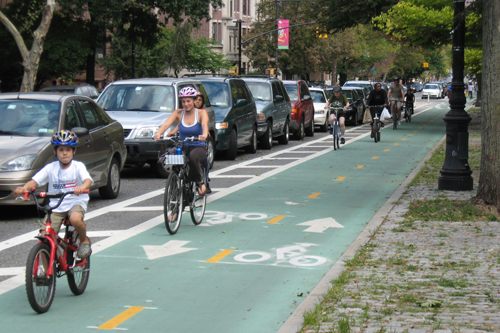When I came back to New York in August after spending three months away, one of the first things I noticed was the increase in bike lanes. As someone who enjoys biking, I thought to myself: “That’s great! Now biking in the city is safer and I can finally get a Citi Bike membership,” which, conveniently, has a station right outside my apartment.
Then I saw some not-so-surprising news: another cyclist death, reinforcing my fears of biking on New York City streets. It’s only October and more cyclists have been killed in the first 8 months of 2016 than in all of last year. In 2015, there were 14 cycling fatalities compared to this year’s 16. Notably, all of this year’s fatalities happened on non-protected bike lanes and most were outside of Manhattan.
The rise in fatalities shows that city transportation officials are still prioritizing cars over bicycles and pedestrians. This approach to city planning is outdated and short-sighted. Bike lanes are tight and concentrated around lower Manhattan. There are few protected lanes on major avenues going into the busy business districts, primarily Midtown. There’s also little advocacy from city officials to encourage bikers to wear helmets (which is also the responsibility of bicyclists themselves).
For years, New York has been trying to market itself as a bike-friendly city, and that effort has paid off. From 1990 to 2015, there has been an increase of almost 300 percent of people commuting to work by bike, with the majority of commuters coming from Brooklyn and Manhattan. But even with Mayor Bill de Blasio’s Vision Zero, which calls for zero traffic-related deaths by 2024, the city must do more to protect bicyclists and quell their fears on the roads.
Biking in the city can be pretty scary. Competing with motorized vehicles, where drivers are better protected in their steel armor, cyclists often feel vulnerable with only a helmet to protect them. The lack of visible, clearly-defined and protected green lanes also hurt bikers, who must ride side-by-side with drivers who often don’t think about the safety of others on the street.
In theory, biking in New York is the best mode of transport. It’s better than waiting for regularly delayed subways and buses, and it’s much faster than walking across long avenues. It is also good for one’s health and environmentally friendly. Studies have shown that bike lanes can help calm traffic, something that de Blasio acknowledged in his Vision Zero plans.
Besides a zero fatality rate, the mayor’s ambitious plan includes the construction of 75 more bike lanes by the end of this year, 18 of which will be fully protected. This project is opportune, as a recent Department of Transportation study revealed a 320 percent increase in daily cycling (including commutes) between 1990 and 2014, from 100,000 riders to 420,000.
But despite the uptick in ridership and increase of bike lanes over the years, it has not been sufficient to prevent an increase in accident and fatality rates. “No cyclist death is acceptable and that’s why we’ll continue raising the bar to keep riders protected,” de Blasio said in a statement last month about Vision Zero.
Is de Blasio’s commitment to zero fatalities enough to make it a reality?
Cycling advocates argue that it’s not. De Blasio allocated $115 million for his Vision Zero capital projects, but Paul White, the executive director of Transportation Alternatives, noted that in order to meet the 2024 deadline, the city will need to spend $250 million— annually. The City Council proposed a budget increase to meet Vision Zero goals in July, but de Blasio refused to accept it. This means that the chance of achieving zero traffic-related deaths in eight years is nowhere in sight.
New York should take a cue from its neighbors across the pond. Cities across Europe have invested in a sustainable biking infrastructure to help accommodate the growing population of cyclists. From Copenhagen, which has long been heralded as the model bike city, to London, which has recently invested £300m in its cycling infrastructure, and most recently Paris, where a major section of the Seine riverbank is set to be completely pedestrianized, European cities illustrate the increasing popularity of biking as a mode of transport.
In those European cities and other bike-friendly cities in America, city planning is human-centered where cars take the backseat. It shows that biking can be a valuable and vital mode of transportation when it is well integrated into a city’s infrastructure. As an example, Copenhagen dedicates a quarter of its road budget to cycling infrastructure, and as a result 75 percent of the city’s population bike year-round and 76 percent of cyclists feel safe on the road.
In New York, both bike riders and city officials must work toward creating a more bike-friendly city. Adding more green lanes is a step in the right direction, but it’s not enough. The city administration needs to invest much more funds in redesigning and building infrastructure that extends the bike lane network, especially in boroughs outside of Manhattan. Without making streets safer, the city continues to put civilian lives at risk.








